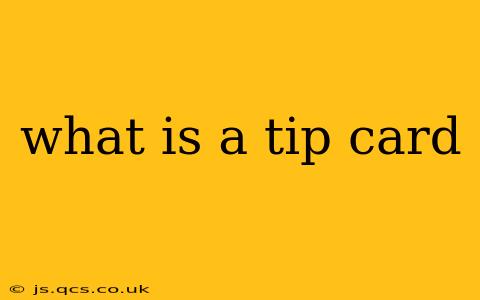Tip cards, also known as tip sheets or suggestion cards, are concise, visually appealing documents designed to provide quick, actionable information on a specific topic. They serve as handy references, offering guidance, advice, or instructions in an easily digestible format. Unlike lengthy manuals or guides, tip cards prioritize brevity and impactful visual elements to convey information efficiently. Think of them as cheat sheets for real-world situations, offering focused information to help users achieve a specific goal or improve their performance.
What are Tip Cards Used For?
Tip cards find applications across diverse fields, offering versatile utility depending on their target audience and purpose. Here are some common uses:
- Customer Service: Businesses employ tip cards to train employees on handling specific customer inquiries or situations, ensuring consistent service delivery and efficient problem resolution.
- Education: Teachers use tip cards to reinforce learning concepts or provide students with quick study guides, focusing on key takeaways or memorization techniques.
- Training and Development: In corporate settings, tip cards are valuable tools for onboarding new employees, providing concise guidelines on company policies, software usage, or safety procedures.
- Marketing and Sales: Tip cards can be incorporated into marketing materials to offer helpful advice or highlight product benefits, enhancing customer engagement and driving sales.
- Healthcare: In healthcare settings, tip cards might provide patients with concise aftercare instructions, medication reminders, or dietary advice.
- Personal Use: Individuals also create tip cards for personal productivity, such as language learning, fitness goals, or time management strategies.
What Makes a Good Tip Card?
Several key features contribute to the effectiveness of a tip card:
- Conciseness: Information should be presented succinctly, focusing on key points and avoiding unnecessary details.
- Visual Appeal: Use of clear headings, bullet points, visuals (icons, images), and whitespace enhances readability and memorability.
- Actionable Advice: Tip cards should provide practical, easy-to-follow steps or recommendations.
- Targeted Information: Focus on a specific topic or goal, avoiding a broad or scattered approach.
- Easy-to-Read Format: Employ a clear, concise font, appropriate font size, and a logical layout.
What are the Different Types of Tip Cards?
While the fundamental purpose remains consistent, tip cards can vary in their specific design and application.
- Single-Topic Tip Cards: These focus on one specific area of expertise or a particular task. For example, a tip card might solely focus on "Troubleshooting Wi-Fi Issues."
- Multi-Topic Tip Cards: These can encompass multiple related topics under a broader theme. For instance, a card might cover various "Customer Service Handling Techniques."
- Checklist Tip Cards: These often feature a checklist format to ensure that all necessary steps are completed. This is commonly used in safety procedures or process management.
- Infographic Tip Cards: These combine visual elements like charts and graphs with textual information for a more engaging presentation.
How to Create Effective Tip Cards
Crafting effective tip cards involves careful planning and design. Consider these steps:
- Identify your target audience: Understand their knowledge level and needs to tailor the information effectively.
- Define your objective: What key information or advice do you want to convey?
- Develop concise content: Break down complex information into easily digestible chunks.
- Choose appropriate visuals: Images, icons, and other visual aids enhance understanding and engagement.
- Employ a user-friendly layout: Ensure easy navigation and readability.
- Test and refine: Get feedback on your tip card to identify areas for improvement.
Frequently Asked Questions About Tip Cards
What is the difference between a tip card and a fact sheet?
While both offer concise information, fact sheets tend to be more data-heavy and less focused on actionable advice. Tip cards emphasize practical guidance and immediate application.
What software is best for creating tip cards?
Various software options exist, including Microsoft Word, Google Slides, Canva, and Adobe Illustrator, offering different levels of design capabilities.
How long should a tip card be?
Ideally, a tip card should be brief enough to be easily read and understood at a glance, typically fitting on a single page or even a smaller card.
By understanding the purpose, design principles, and creation process of tip cards, you can harness their power to effectively communicate information, guide actions, and achieve desired outcomes across a wide range of applications.
